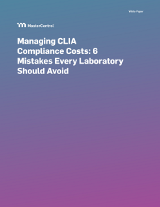
GxP Lifeline
CLIA Certification: 3 Things You Need to Know
 Whether your laboratory is testing for potentially life-altering diseases like COVID-19 or drawing blood for basic metabolic panels, the patients you are testing expect the results of those tests to be entirely accurate. To ensure the reliability and precision of their patient’s test results, clinical laboratories in the U.S. must adhere to the regulations defined in the Clinical Laboratory Improvement Amendments (CLIA).
If your laboratory currently conducts or plans to conduct testing on humans and you’re wondering how CLIA applies to your facility, there are three fundamental questions that first must be addressed.
Whether your laboratory is testing for potentially life-altering diseases like COVID-19 or drawing blood for basic metabolic panels, the patients you are testing expect the results of those tests to be entirely accurate. To ensure the reliability and precision of their patient’s test results, clinical laboratories in the U.S. must adhere to the regulations defined in the Clinical Laboratory Improvement Amendments (CLIA).
If your laboratory currently conducts or plans to conduct testing on humans and you’re wondering how CLIA applies to your facility, there are three fundamental questions that first must be addressed.
#1. Is CLIA certification required for my laboratory?
All laboratories in the U.S. that perform testing on humans — approximately 260,000 laboratories nationwide — are generally subject to the CLIA laboratory testing regulations enforced by the Centers for Medicare & Medicaid Services (CMS). CLIA quality control standards were established in 1988 and apply to any facility that performs even one applicable test on “materials derived from the human body for the purpose of providing information for the diagnosis, prevention, or treatment of any diseased or impairment of, or the assessment of the health of, human beings.”(1) Any facility that conducts testing for these purposes is considered to be a laboratory within the scope of CLIA. They must therefore be certified with the CLIA program that corresponds with the complexity of the tests performed.
There are two states, New York and Washington, that maintain their own CMS-approved regulatory programs for clinical laboratories. Facilities in those states should contact the appropriate state agency to determine whether separate CLIA certification is needed.
There are also three unique types of human-testing laboratories that are not subject to CLIA certification:(2)
- Research laboratories that test human specimens but do not report patient-specific results for the diagnosis, prevention or treatment of any disease or impairment of, or the assessment of the health of, individual patients.
- Laboratories that only perform testing for forensic purposes.
- Laboratories certified by the Substance Abuse and Mental Health Administration (SAMHSA) in which drug testing is performed according to SAMHSA guidelines.
#2. Are there different types of CLIA certificates?
The regulatory requirements of CLIA vary based on the types of tests a laboratory performs. CLIA regulatory requirements classify testing into three categories: high complexity, moderate complexity and waived. There are five different types of CLIA certifications, and each is generally effective for two years.(3)
Certificate for Provider-performed Microscopy (PPM) procedures:
These certificates are issued to labs in which physicians, midlevel practitioners or dentists perform specific types of moderate complexity testing during a patient’s visit.
Certificate of Compliance (COC):
These certificates are issued to a laboratory after a CMS surveyor or state agency has conducted an inspection and determined the laboratory to compliant with applicable CLIA requirements.
Certificate of Accreditation (COA):
These certificates are issued to a laboratory based on its endorsement by a CMS-authorized accrediting organization.
Certificate of Registration:
These certificates allow a laboratory to continue performing high complexity and/or moderate testing until it is inspected and evaluated for its compliance with CLIA regulations. Only laboratories applying for a COC or COA may receive this type of certificate.
Certificate of Waiver (COW):
CLIA guidelines define waived tests as those that can be categorized as “simple laboratory examinations and procedures that have an insignificant risk of an erroneous result.”(4) A laboratory may qualify for a COW if it only conducts tests that:
- Pose no risk of harm if performed incorrectly.
- Employ methodologies that are so simple as to render the likelihood of erroneous results negligible.
- Are cleared for home use by the U.S. Food and Drug Administration (FDA).(5) These types of tests include ovulation tests, urine pregnancy tests and blood glucose tests via glucose monitoring devices approved by the FDA for home use. The complete list of waived tests sorted by analyte name can be found on the FDA website.
#3. How does a laboratory apply for CLIA certification?
The application for CLIA certification, Form CMS-116, is available on the CMS website. Once completed, the application must be delivered to the local agency for the state in which the laboratory facility is located. (A current list of state agencies can be found on the CMS website.) Some survey agencies have state-specific requirements, so it’s always prudent to contact the appropriate state agency prior to submitting an application.
If a laboratory has more than one location, a CLIA certificate is needed for each facility unless the laboratory:
- Is not at a fixed location (e.g., mobile testing units, testing performed at health fairs, etc.).
- Is a federal, state or local government or not-for-profit laboratory that is engaged in limited public health testing.
- Includes multiple hospital labs located within contiguous buildings on the same campus and under common direction.
Accelerate Your CLIA Certification
To learn how digitization can streamline your laboratory’s CLIA compliance processes, visit our compliance information page.
References:
- CFR Title 42, Part 493—Laboratory Requirements, Electronic Code of Federal Regulations, data updated Oct. 7, 2020.
- “How to Obtain a CLIA Certificate,” U.S. Department of Health and Human Services, March 2019.
- Supra note 2.
- Supra note 2.
- Supra note 1, Part 493.15
Free Resource

Enjoying this blog? Learn More.
Managing CLIA Compliance Costs: 6 Mistakes Every Laboratory Should Avoid
Download Now